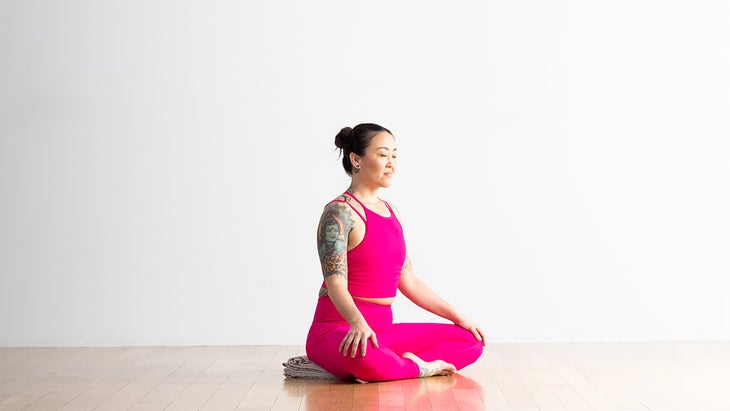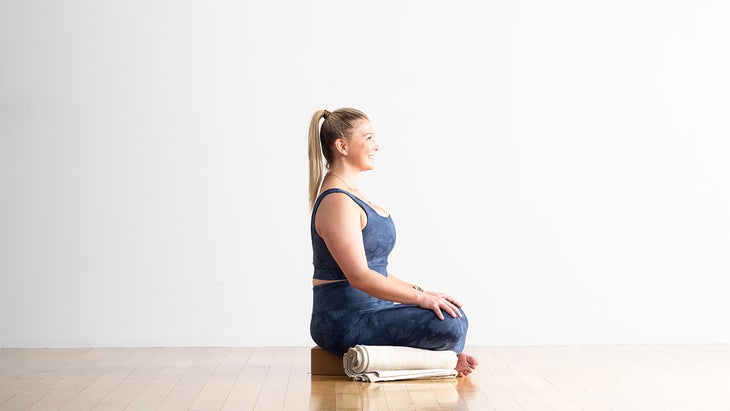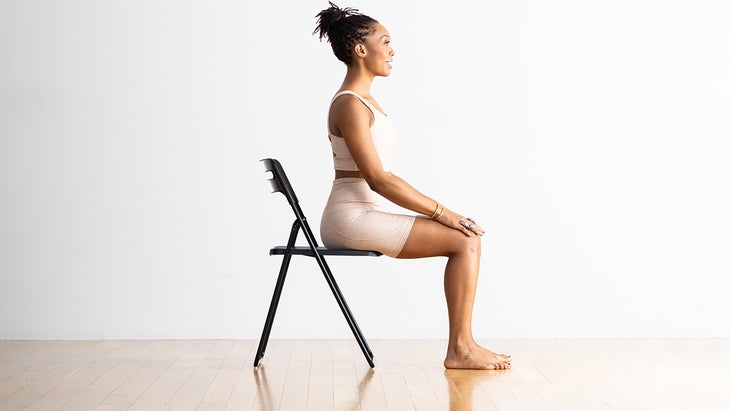Heading out the door? Read this article on the new Outside+ app available now on iOS devices for members! Download the app.
Yogis have been practicing Sukhasana (Easy Pose) for centuries as a preferred posture for meditation. In many yogic traditions, the main purpose of Easy Pose is to drop into a meditative state. “Sukh” can also mean happy or joyful in Sanskrit, which is a feeling we hope to find within ourselves in a meditation practice. Sukhasana is one of the many paths to get there.
Easy Pose may have been easy when you were a child, but as an adult, sitting cross-legged can be tricky. Our joints are no longer accustomed to the required rotation and flexibility, thanks to a chair-oriented culture that can cause tight hips and achy knees. Sitting in a chair for several hours a day encourages your body to lean back and sink into your midsection. If you work at a computer, you may lean forward and round your shoulders. Sukhasana, on the other hand, requires you to engage your core and back muscles to distribute your weight evenly over your sit bones. You also have to balance your shoulders over your hips and align your head with the rest of your spine. The pose helps stretch the hips and ankles, and strengthen back and abdominal muscles.
Easy Pose basics
Sanskrit: Sukhasana (sook-HAHS-ah-nah)
Pose type: Seated
Target area: Hips
Why we love it: “I tend to always begin my yoga practice here, from a humble and grateful place,” says Stephany McMillan, founder Rise and Flow Yoga. “Oftentimes the work that happens in your body here is overlooked. I’m reminded by my anatomy professor to keep the structural and functional goal of every posture top of mind. In this posture, I have learned to soften the subtle muscles in the face and shoulders, and use Easy Pose to practice activating the abdomen while maintaining the integrity of my posture and spine. After making these mindful adjustments and modifications, I am able to enter into a gentle meditation, softening the gaze and engaging an intentional rhythm of breath. I repeat mindful reminders to myself here that I also take with me throughout my day.”
Easy Pose benefits
Easy Pose can be calming and relaxing—if you’re able to sit in it comfortably. It improves postural awareness, creates a foundation for meditation practices, and can help manage stress. When done in a relaxed manner, this pose activates the relaxation response (parasympathetic nervous system) and deactivates the stress response (sympathetic nervous system). Easy Pose may also help lower or regulate blood pressure. Holding it strengthens core muscles (including your abdominals and the muscles supporting your spine), and stretches your groin and inner thighs (adductors).
Easy Pose: Step-by-step instructions
- Sit on your mat in Dandasana (Staff Pose). Bend and widen your knees and cross your shins. Slip each foot beneath the opposite knee and bring the shins toward your torso.
- Relax your feet so their outer edges rest comfortably on the floor and the inner arches settle just below the opposite shin. There should be a comfortable gap between your feet and the pelvis.
- Keep your pelvis in a neutral position, without tilting forward or back.
- Lengthen your tail bone toward the floor, firm your shoulder blades against your back to lengthen your upper torso. Don’t over arch your lower back or poke your lower front ribs forward.
- Either stack your hands in your lap—one inside the other, palms up—or place them on your knees, palms down.
- You can sit in this position for any length of time, but be sure to alternate the cross of the legs, so that the left leg and right leg have equal time on top.
Beginner’s Tip
Sit with your back to a wall, slightly closer than the length of a yoga block, and wedge the end of the block between the wall and your lower shoulder blades.
Variation: Easy Pose sitting on a blanket

Sit on one or more folded blankets to elevate your hips slightly and offer more space for your hips to open.
Variation: Easy Pose with hip and knee support

Sit on the front edge of a folded blanket or bolter. Lean slightly forward on the prop to help tilt your pelvis forward and create a more neutral spine. If your knees are lifted, place blocks or folded blankets underneath them to alleviate pressure in your hips and knees.
Variation: Easy Pose in a chair

Sit toward the front of a chair with your back away from the back of the chair. Lengthen your tail bone toward the floor and firm your shoulder blades against your back to lengthen your upper torso. Root your feet to the floor with your ankles under your knees so that your legs create a right angle. Place your hands on your thighs or knees, or fold your hands in your lap.